Diamonds are formed deep within the Earth: between 100 km and 200 km below the earth's surface. Diamonds form under remarkable conditions.
The temperatures they are formed at are about 900 - 1300 C in this part of the Earth's mantle where diamonds form. The pressure is between 45 - 60 kilo bars. (kB) 50 kB = 150 km or 90 miles below the surface 60 kB = 200 km or 120 miles below the surface.
Diamonds are carried to the surface by volcanic eruptions. The volcanic magma conduit is known as a kimberlite pipe or diamond pipe. We find diamonds as inclusions in the (rather ordinary looking) volcanic rock known as kimberlite. The kimberlite magmas that carry diamonds to the surface are often much younger than the diamonds they transport (the kimberlite magma simply acts as a conveyer belt). To ensure they are not converted to graphite, diamonds must be transported extremely rapidly to the Earth's surface. It is probable that kimberlite lavas carrying diamonds erupt at between 10 and 30 km/hour (Eggler, 1989). Within the last few kilometers, the eruption velocity probably increases to several hundred km/hr.
All natural diamonds are at least 990,000,000 years old. Many are 3,200,000,000 years old (3.2 billion years) how do we know this? Age: from Carbon dating? No! C-dating only works for very young carbon. You need to use other radioactive decay schemes (e.g., uranium-lead) to date inclusions in diamonds. Inclusions used for dating are around 100 microns in diameter (0.1 mm).
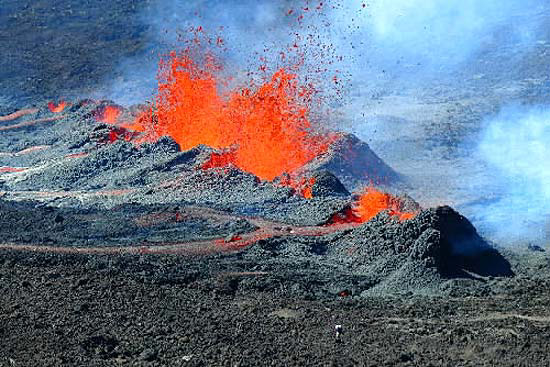
Diamond is the hardest material
Diamond is the hardest gem on the Mohs hardness scale and graphite (also made from carbon atoms) is the softest! The rating of a mineral's "Hardness" or resistance to being scratched can be given using Mohs' scale. This was devised by the German geologist Frierich Mohs (1773-1839).
| Rating | Type mineral | Everyday equivalent |
|---|---|---|
| 1 | Talc | Baby powder |
| 2 | Gypsum | Fingernail |
| 3 | Calcite | Bronze coin |
| 4 | Fluorite | Iron nail |
| 5 | Apatite | Glass |
| 6 | Feldspar | Penknife blader |
| 7 | Quartz | Steel knife |
| 8 | Topaz | Sandpaper |
| 9 | Corundum | - |
| 10 | Diamond | - |
Given that both diamond and graphite are made of carbon, this may seem surprising. The explanation is found in the fact that in diamond the carbon atoms are linked together into a three-dimensional network whereas in graphite, the carbon atoms are linked into sheets with very little to hold the sheets together (thus the sheets slide past each other easily, making a very soft material).
How rare are diamonds? How many grams do you need to mine to get 5 grams of diamonds? (5g/1000 kg) @ 1000 g/kg = 5 g /1,000,000 g! But only 20 % are gem quality (80 % of these are sold in a "managed selling environment") and the remainder are used for industrial purposes (this material is known as "bort" or "carbonado" (carbonado is finer)).
- Basic Data Hardness = 10
- Crystal System = cubic
- Refractive Index = 2.42
- Dispersion = 0.044
- Specific Gravity = 3.52
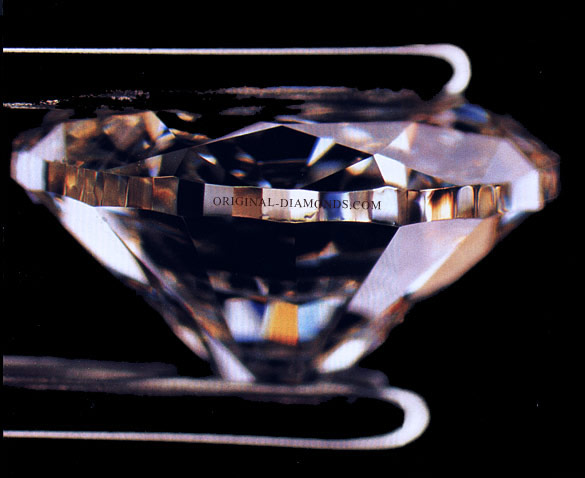
Treatments and synthetics
Fracture filling of cracks and removal of inclusions. Surface cracks fractures and cleavages reaching the surface can be filled with a glass-like material with similar RI.. Identification: when examined with an optical microscope, filled stones will show: greasy appearance, flash effects, bubbles.
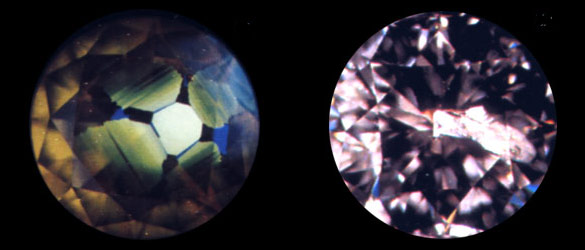
Problem: Filling does not always resist polishing, heating, cleaning, age wear and tare Drilling of inclusions involves using a laser to drill into the inclusion. Solutions can be poured into the resulting "hair-width" diameter hole to bleach colored inclusions. This is compared to getting a filling in your tooth.

Irradiation is used to change the color of the diamond. A common color produced by irradiation are greens yellow and blues, usually very intense and not natural looking.
Laser drilled diamond to remove inclusionsSynthetic diamonds are often yellowish in color (rarely used for gem purposes, more commonly used as diamond grit for industrial purposes. Modern synthesis of thin film diamond has other industrial applications).
A 5 mm diamond (0.5 carat) takes over a week to grow. Synthesis requires:
- high pressure
- high temperature
- a special apparatus
Synthetic diamonds can sometimes be distinguished from natural diamonds by the presence of flux inclusions (Ni, Al or Fe).
Simulants - That try to simulate the appearance of diamond
The distinction between a synthetic diamond (man-made diamond consisting of carbon atoms arranged in the typical diamond structure) and a diamond simulant (not a carbon compound with the diamond structure) is very important!
In order of increasing R.I., the most common simulates are:
- YAG = yttrium aluminum garnet
- GGG = gadolinium gallium garnet
- CZ = cubic zirconia
- Strontium titanate
- Diamond
Another diamond stimulant is synthetic moissanite (Silicon carbide or carborundum) it was introduced to the jewelry market in 1998 it is one of the better simulates to date, but displays double refraction and may turn yellow under the heat of a low flame.
Unexpected carbon composition discovered in world's oldest diamonds Did life on earth begin earlier than we have hitherto believed?
04 Jul 2008 - While examining the oldest diamonds in the world, a group of researchers, including Martina Menneken and Dr. Thorsten Geisler from the University of M?nster (Institute of Mineralogy), have found evidence that life may have existed 4.25 billion years ago. Up to now, scientists have assumed that the first living cells came into being around 3.5 billion years ago. The prestigious magazine "Nature" has published the results in its current edition dated July 3rd, 2008.
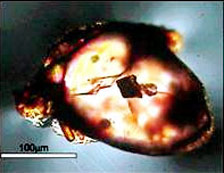
Martina Menneken and her colleagues had already made news in 2007 when they discovered the oldest diamonds in the world. Since then a team consisting of scientists from Australia, Sweden and M?nster have been continuing their analysis of the diamond and graphite inclusions in zircons from western Australia which are only a few micrometres in size and up to 4.25 billion years old. In the course of their work the researchers have found some unexpectedly low content of the heavy carbon isotope C-13. Small amounts of this isotope are typical of carbon originating from organic material.
With the aid of a secondary ion mass spectrometer the scientists have measured the proportions of various carbon isotopes (C-12 to C-13) in the inclusions in order to get more information about where the carbon came from and how the diamond and graphite inclusions arose. The proportions measured range from typical values found in the earth's crust to values characterized by an extremely low amount of the heavy C-13 isotope.
"The composition of the carbon isotopes is an indication that life may have existed 4.25 billion years ago," says Martina Menneken. However, abiogenic chemical reactions may also have caused low amounts of heavy carbon. What is certain is that very soon after the formation of the earth 4.56 billion years ago there must have existed on earth a carbon reservoir with extremely low amounts of C-13.
"Our data do not prove the existence of life 4.25 billion years ago," says Menneken, "but they do raise the question of how this unexpected carbon composition arose." The presence of living organisms is one possible explanation. If it should turn out to be true, the history of life would have to be rewritten.
Original publication: Nemchin et al.: A light carbon reservoir recorded in zircon-hosted diamond from the Jack Hills. Nature 454, 92-95, 2008.
Diamonds hint at 'earliest life'
By Jonathan Fildes
Science and technology reporter, BBC News
Tiny slivers of diamond forged on an infant Earth may contain the earliest traces of life, a study has shown.
Analysis of the crystals showed they contain a form of carbon often associated with plants and bacteria.
The rare gems were found inside zircon crystals, formed a few hundred million years after the Earth came into being.
Writing in the journal Nature, the researchers caution that their results are not definitive proof of early life but do "not exclude" the possibility.
"We're all a little sceptical," said Dr Martin Whitehouse of the Swedish Museum of Natural History and one of the authors of the paper.
If the carbon was derived from primitive organisms, it would push back the date for life appearing on Earth by around 500 million years, to beyond 4.25 billion years ago. The Earth itself is just 4.6 billion years old.
"When you look at the carbon isotopes, they could be interpreted as biogenic because we know that biologic processes do generate light carbon isotopes. But of course there are other processes that can do that," Dr Whitehouse told BBC News.
"The most common way to form light carbon on the modern Earth is photosynthesis" Alexander Nemchin.
Other possibilities include chemical reactions involving carbon oxides or even the material being delivered from space by meteorites.
However, some observers have raised the possibility that the diamonds may be contamination, introduced during polishing of the zircons.
"If you look at the photos that they present, you always see these diamonds sat in cracks and fissures and cavities," Professor Minik Rosing of the University of Copenhagen told BBC News.
If they were original features, he said, you would expect at least some to be embedded within the structure of the crystals.
"There is always fear that they might actually not be primary."
However, Dr Rosing explained, the possibility that the signatures were from early Life was "tantalising".
Time capsules

The tiny zircon crystals - just 0.3mm across - were found in the Jack Hills of Western Australia. They are the tough remnants of ancient rocks that have long since disappeared.
"We don't have the rocks. These zircons are just little fragments of something that was broken up, weathered and redeposited as sediments," explained Dr Whitehouse.
Radioactive dating has suggested that some of the crystals formed as far back as 4.4 billion years ago.
Scientists describe this phase in Earth history as the Hadean, and it has long been thought that it would be impossible for life to begin at this time because of the inhospitable conditions on the young planet.
But the Jack Hills zircons have begun to cast doubt on this theory.
Earlier work raised the intriguing possibility that the infant Earth would have been cooler and wetter than previously thought as the crystals show evidence of growing out of a low-temperature magma that had been in contact with water.
The new analysis of the diamond and graphite inclusions in the crystals could lend further weight to this theory.
"I think there is an interesting possibility here," said Dr Whitehouse.
Deep understanding
The scientists analysed 22 graphite and diamond inclusions in 18 zircon crystals.
The results showed that the capsules had unusual levels of a light form, or isotope, of carbon, known as carbon 12.
"The most common way to form light carbon on the modern Earth is photosynthesis," explained Dr Alexander Nemchin of the Curtin University of Technology, Australia, and another author of the paper.
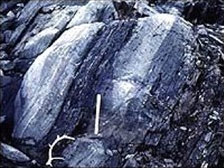
During this process organisms preferentially extract light carbon, leaving heavier forms in the atmosphere.
The Isua Belt may contain chemical traces of ancient life.
"When they die, they preserve that signature," he said.
The results of the team's experiments show that the carbon inclusions have a range of isotopes, which suggested, they said, that the carbon reservoir was "heterogeneous".
This would then have had to be buried deep inside the Earth to generate the extreme pressures required to turn it into diamond.
"If this stuff was life - which then would have presumably formed on the surface - you do then need a process to take it down to something like 150km or 200km," said Dr Whitehouse.
On the modern Earth, crust is recycled at depth in so-called subduction zones, such as those found along the edge of the Pacific Ocean. Here, cool, dense oceanic crust plunges under the buoyant and long-lived continental crust.
Previous work on the diamonds supports the notion that similar processes were occurring on the Hadean Earth.
But not all scientists agree; instead they suggest that the early crust was relatively stable. Either way, Dr Whitehouse does not believe that this rules out a biogenic origin for the carbon.
"All this tells you is that there could have been a process that put things down to 200km," he said. "There may have been other things happening that we don't know about."
Open questions
However, the team readily admit that the conclusion is not definitive.
Currently, what is thought to be the oldest signature of life by some - dated at around 3.7bn years old - was discovered by Professor Rosing in an area of intensely deformed rocks in West Greenland known as the Isua Belt.
"That to me is completely the opposite of a biological signature" Minik Rosing
Here, chemical traces again suggest the presence of photosynthetic life forms. But crucially the signature is seen in a complete sequence of rocks rather than isolated crystals.
This gives geologists clues about the environment in which the rocks were laid down and whether or not they could feasibly have contained life.
"The problem with the Jack Hills is that we don't have the rock," admits Dr Whitehouse "The carbon isotopes alone are not a distinct biosignature."
As a result they have suggested other possibilities for the origin of the carbon including inorganic chemical reactions, similar to those that take place in the catalytic converter of a car.
Professor Rosing believes that this is the most likely explanation. He points to the range of carbon values that were found in the inclusions.
"That to me is completely the opposite of a biological signature," he said. "That's the signature of some chemistry - a fractionation process or something."
Photosynthesis, he explained, would produce constant values for the carbon isotope ratios. Another possibility, the team suggests, is that the carbon came from so-called "chondritic" meteorites, which also have a similar chemical signature.
This theory is appealing as the Hadean is thought to have ended roughly 3.8bn years ago with a period of intense bombardment believed by some to have initiated the emergence of life on Earth.
However, according to Professor Rosing, if the diamonds and zircons are extraterrestrial it undermines every other theory related to the zircons, including the possibility of a cooler, more habitable early Earth.
"If that is the case, then every other argument about these zircons falls apart, he said. "Then we don't know anything."


